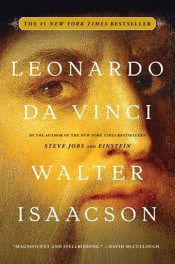Leonardo da Vinci

This is a lovely, comprehensive biography of one of the greatest thinkers in history.
This is one of the rare biographies I read of someone who lived so long ago that exact records are not available. There is no video footage of Da Vinci’s life. There are no photographs of him. No newspapers quoted him.
That lends a different tone to the book. It’s more an exploration of the world he lived in, and the things he left behind – his sculptures, his paintings, and his notes.
…and there are so many notes. Da Vinci left behind over 7,000 pages of notes. He recorded everything – both statements of fact and observation, and lists of things he wanted to do or research.
What we’re left with is the record of perhaps the most curious man who ever lived. Da Vinci investigated things just for the sake of doing it. He had no higher purpose, really. He never wanted to be rich. He looked for a generous patron, and also made some money selling art. But he pursued knowledge just for the sake of knowing things.
Walter Isaacson is a biographer of some repute. He injects himself in the book a bit by providing his interpretations of Da Vinci’s work and his opinions of disputed points around Da Vinci’s life (for example, was he gay?). Isaacson also spends a lot of time discussing and dissecting his paintings, including an entire chapter on The Mona Lisa.
The best part of the book is the very end, where Isaacson sums up what we can learn from Da Vinci’s life:
- Be curious, relentlessly curious
- Seek knowledge for its own sake
- Retain a childlike sense of wonder
- Observe
- Start with the details
- See things unseen
- Go down rabbit holes
- Get distracted
- Respect facts
- Procrastinate
- Let the perfect be the enemy of the good
- Think visually
- Avoid silos
- Let your reach exceed your grasp
- Indulge fantasy
- Create for yourself, not just for patrons
- Collaborate
- Make lists
- Take notes on paper
- Be open to mystery
Some of these sound a little weird, but they make sense with the longer explanation and from having the context of the book as a whole.
I absolutely loved this format. Isaacson wasn’t trying to be obtuse – he literally just listed out the major takeaways from Da Vinci’s life. More biographies and organizational histories should do this.
Finally, the book – at least the version I got – is physically beautiful. Very heavy, bright glossy paper, and full-color images of Da Vinci’s paintings spread throughout.
Book Info
- I have read this book. According to my records, I completed it on .
- A hardcover copy of this book is currently in my home library.